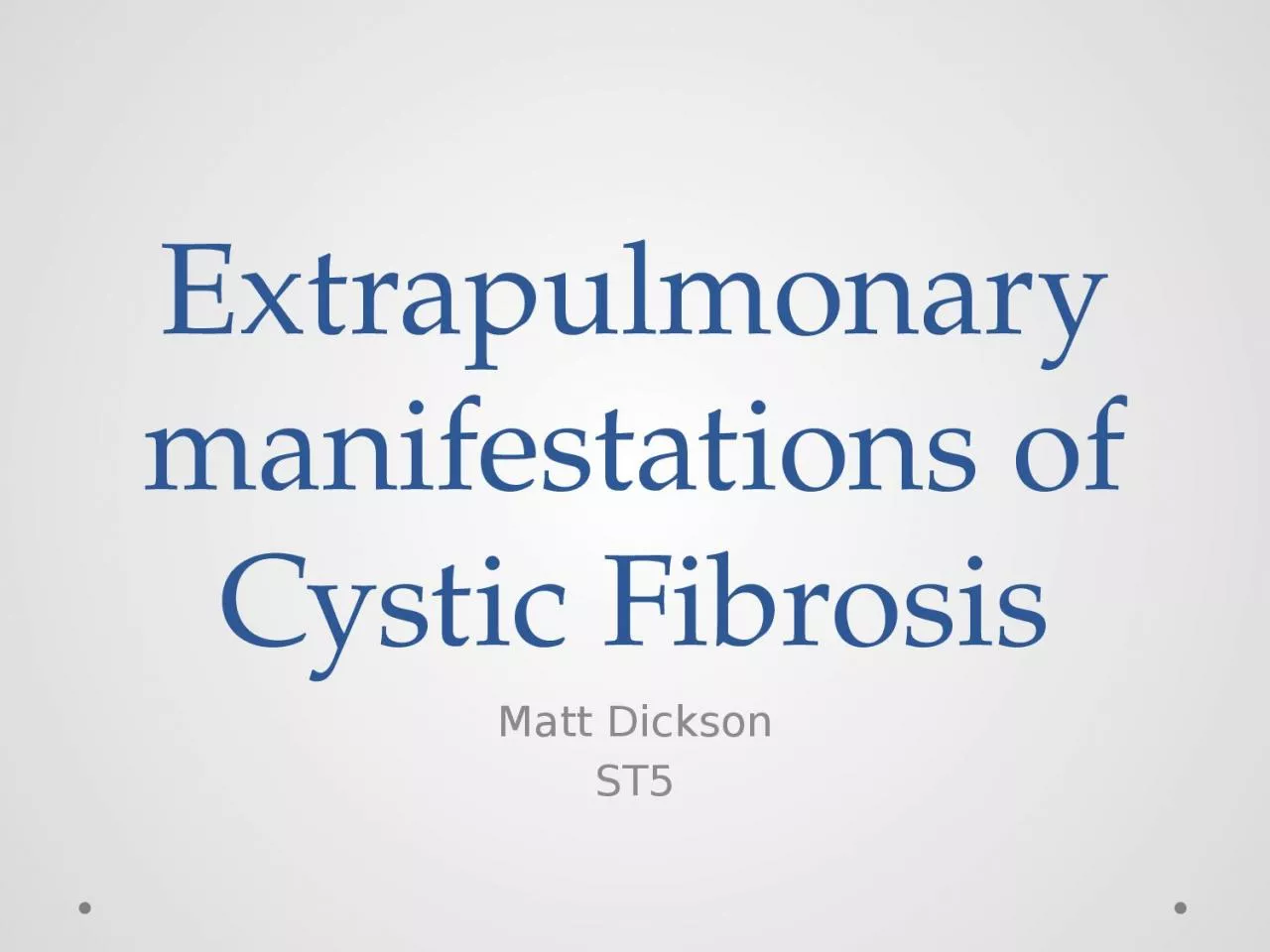

Matt Dickson ST5 Introduction Case study CF related liver disease CF related diabetes CF related GI disease And the rest Case study 27 year old male F508delF508del diagnosed aged 2 ID: 1042670
Download Presentation The PPT/PDF document "Extrapulmonary manifestations of Cystic..." is the property of its rightful owner. Permission is granted to download and print the materials on this web site for personal, non-commercial use only, and to display it on your personal computer provided you do not modify the materials and that you retain all copyright notices contained in the materials. By downloading content from our website, you accept the terms of this agreement.
1. Extrapulmonary manifestations of Cystic FibrosisMatt DicksonST5
2.
3. IntroductionCase studyCF related liver diseaseCF related diabetesCF related GI diseaseAnd the rest…
4. Case study27 year old male F508del/F508del – diagnosed aged 2Under care of Leeds CF teamMaster’s Degree, Newcastle (started Sept 2017)Care transferred (temporarily) to Newcastle
5. Case studyBackground:Stable lung function (FEV1 ~ 70% predicted)Intermittent compliance with Acapella and PulmozymeOral antibiotics annually, x1 course IVs in 12 yearsCF related liver disease, splenomegaly and portal hypertensionOesophageal varices (on propranolol)Assessed for liver transplantation 2015On Ursodeoxycholic acid for “as long as I can remember”CF related diabetesCF related arthropathyDistal intestinal obstructive syndrome 2005Osteopenia (T score spine -1.2)
6. Case studyWorsening abdominal distension September 2017Attended “Stag – do” beginning SeptemberAscitic drain placed (transudate)7 litres drainedDischarged with spironolactone 100mg ODReviewed following dischargeRe-admitted due to re-accumulation of ascitesTransferred care to Leeds CF Unit, for reassessment by local Liver team
7. Extrapulmonary diseaseMulti-system diseaseCFTR essential for water/solute movementPresent in epithelial cells of:LungLiverPancreasGutReproductive tractSkinInadequate hydration of mucous secretions, leading to organ dysfunction
8.
9. CF related liver diseaseSpectrum of diseaseRaised transaminases (30-40%) → cirrhosis and portal hypertension (10%)CFTR located in biliary epithelium, not hepatocyteAssociated with severe CFTR mutationsRisk factors – meconeum ileus, male, pancreatic insufficiencyHepatic steatosis common (60%) – benign courseNeonatal cholestasis (10%) – does not predict later CFLD
10.
11. DiagnosisTwo or more of:Hepatomegaly and/or splenomegaly, confirmed by ultrasoundAbnormalities of ALT, AST, and GGT above the laboratory upper limits of normal for >6 months, after excluding other causes of liver diseaseUltrasound evidence of coarseness, nodularity, increased echogenicity or portal hypertensionLiver biopsy showing focal biliary cirrhosis or multi-lobular cirrhosis
12. ScreeningPhysical examinationLaboratory testing:Mild derangement in LFTs commonALP often out of proportion to AST/ALTThrombocytopenia/drop in platelet countHypoalbuminaemia/coagulopathyUSS (+/- doppler)
13. ManagementNutritionRisk reductionUrsodeoxycholic acidOGDBeta blockersTIPSLiver transplantationLiver-lung transplantation (4% children, 25% adults)
14. Indications for liver transplantationIntractable variceal bleeding Ascites and jaundiceProgressive hepatic dysfunction (hypoalbuminemia and coagulopathy)Hepatopulmonary syndromePortopulmonary hypertensionDeteriorating pulmonary function, if this is thought to be a consequence of the liver disease (e.g hepatopulmonary syndrome)Severe malnutrition, unresponsive to intensive nutritional support and treatment for cystic fibrosis-related diabetes, if present
15. OutcomesSimilar to those with other forms of liver disease1 year survival ~ 85%5 year survival 64-78%Survival similar for liver/liver-lung transplantation
16.
17. CF related diabetesSeparate to Type 1/Type 2Slowly progressive insulin deficiencyInsulin resistancePostprandial hyperglycaemia → Fasting hyperglycaemia (HbAlc response)Rarely associated with islet cell autoantibodiesKetoacidosis rare~50% patients >40 years
18. Risk factorsPancreatic insufficiencySevere genotypeIncreased ageFemale genderLung functionImpaired nutrition/growthLiver disease
19. Impact of CFRDLung functionNutritional statusVascular complicationsMortality
20. ScreeningAnnually, from 10 yearsOGTTHbA1c (low sensitivity for CFRD)Interpretation of OGTT:Normal glucose tolerance – fasting <5.6mmol/L and two hour glucose <7.8mmol/LImpaired fasting glucose – fasting 5.6-7mmol/LIndeterminate glycaemia – one hour peak >11.1mmol/L, normal two hour/fasting glucose (unique to CF)Impaired glucose tolerance – two hour glucose 7.8-11.1mmol/L CFRD:Without fasting hyperglycaemia – two hour >11.1mmol/L, fasting <7mmol/LWith fasting hyperglycaemia – two hour >11.1mmol/L, fasting >7mmol/L
21. TreatmentInsulinRemove catabolic effectHbAlc <53mmol/mol (7%)Maintain substantial calorie intakeLow glycaemic indexMonitoring for complications +/- primary prevention
22. Pancreatitis10% with pancreatic sufficiencyRare in pancreatic insufficientLate adolescence/early adulthood?CF related/Idiopathic pancreatitis
23.
24. CF related GI diseaseGORD30-40% symptomatic90% may silently aspirateMeconeum Ileus~80% will have CFConstipation25-50% DIOSUnique to CFPainRight lower quadrant mass“Foamy” gas pattern in right flank +/-dilated small bowel loops/fluid levelsMedical treatment
25.
26.
27. Musculoskeletal disordersOsteopenia/osteoporosisVitamin D malabsorptionPoor nutritional statusReduced physical activitySteroidsHypogonadismDEXA scans >18yrCF related arthropathyLarge jointsNon-erosiveResponds well to NSAIDs5% patientsFever/erythema nodosum
28.
29. Reproductive systemMen:Normally infertile – failure of development/blockage of vas deferensTesticular histology normal (sperm retrieval an option)Women:Subfertile (always offer contraception)Physical state optimised prior to pregnancyRisks to mother and babyRisk of diabetesPAH contraindication
30. ConclusionNot just the lungsFocus on other systems Need to be vigilant of developing complicationsConsider other differentialsNew word of the day…Inspissated